Home roses: the best varieties, cultivation and care
It is not always possible to grow roses in summer cottages. In such cases, breeders delight with varieties of home flowers, the place for which is indoors. But in order for the beauties to bloom, you need to know everything about the care and growing of a houseplant.
Home roses do not differ in appearance from garden roses. The only thing is that the length of their stem is shorter and the flowers are smaller. They also have shoots that are half woody and covered with thorns. The brightly colored buds give off a pleasant smell, although there are species without a scent. Growing and caring for indoor flowers is not difficult, especially if representatives of the Rosaceae family already grow in the garden.
Content:
- Popular varieties of room roses
- Breeding methods for a home flower
- Terms and rules for planting a plant
- Growing conditions: temperature, light, humidity
- Rose care recommendations - watering and feeding
- Rose bush transplant and pruning technique
- The main diseases and pests of ornamental plants, methods of dealing with them
- Design ideas for using roses in interior decoration
Popular varieties of room roses
There are hundreds of varieties of roses created for windowsill living. The following types of plants are especially popular:
- Bengal roses are famous for their unpretentious care. The shoots of the plant form bushes up to half a meter high. Both the leaves and the flowers are small in the species. But the inflorescences delight with a riot of colors continuously, throughout the year with a short break for rest. Of the best varieties of the species, Pink Grothendorst is interesting, blooming both in spring and in the middle of summer. Flowers do not fade for a long time, keeping freshness. It is the only cultivar to shed its foliage in late summer, although new leaves grow very quickly. At the Clotilde rose, Super pinkish flowers cover the entire bush, attracting with their aroma. The buds of the Ophelia variety are also fragrant, and the Bourbon rose bushes are always covered with many apricot flowers.
- Miniature types of roses do not reach a height of thirty centimeters. They breed well, are picky about care. A species was bred from dwarf teahouses crossed with other roses. Of the varieties of miniature roses, Cardana is known. The color of the flower petals is diverse, it is constantly actively developing. An interesting plant is Green Ice, which has delicate pale green inflorescences against the background of dark green foliage.
- The varieties of Bengal flowers were used in the creation of tea roses. Terry inflorescences are famous for their unique smell. Of the best varieties, Marshal Niel is distinguished with yellow buds, Nifetos, the petals of which are pale pink on top, and darken towards the middle.
- Polyanthus roses are characterized by many flowers. Brushes of double and semi-double inflorescences look beautiful on the branchy bushes of a houseplant. The Triumph variety exudes aroma with its red flowers against a background of large green leaves.
All types of domestic roses are short bushes. The color passion of rose lovers can be satisfied with the variety of varieties.
Breeding methods for a home flower
Usually, the cuttings method is used to propagate roses, as it is simple and effective. But its disadvantage is weak root system the resulting plant. For reproduction, strong shoots are taken, which are cut off near the leaf bud. Before planting, the lower part of the cuttings is dipped into a growth stimulator solution. Then the prepared shoots are placed in an earthen substrate or a jar with a little water for rooting.
As soon as a thickening appears at the end of the cutting - callus, you can calm down - the roots will develop in a week or two.
Such a shoot is already ready for transplanting into a pot with a soil mixture of sand, peat, turf, compost... The plant will harden faster if you cover it with a film or jar on top, creating conditions for a greenhouse. The emergence of new shoots will be a signal that the rose has taken root and started growing. Now it needs to be hardened by removing the plastic cap. The best breeding time by cuttings is in early spring and during the summer.
When transplanting a rose bush, you can neatly separate a part of the root system with a bud. Having transplanted the shoot into another container, it is cut off by a third. And then careful care is needed, leading to further growth of the bush. A careful approach to the propagation of a houseplant contributes to decorating the house with different varieties of flowers.
Terms and rules for planting a plant
Roses for growing in the house are usually purchased in a specialty store or transplanted undersized varieties from their garden. Before planting, you need to pick up a container for a flower. The best choice would be a clay pot, through the walls of which the plant, its root system, will breathe. In such containers, excess moisture is not retained in the soil. But in plastic containers, there must be holes at the bottom so that excess moisture goes into the pallet.
The container is filled with a drainage layer, and then with fertile loose soil.
Before planting, carefully examine the root system, which should be intact, without damage. Ideal if the roots look strong and light. It is possible, in the presence of excessively dense roots, to divide them into two shoots. If the purchased flower has buds, then it is better to cut them off. After lightly compacting the soil in the pot, make a depression for the rose. Putting the stalk in the middle of the container, sprinkle it with soil. As soon as the earth covers the root system, it is crushed.
It is necessary to pay attention when planting that the second knot of the cutting is above the ground. Then it is imperative to water the plant with the addition of a growth stimulant solution. To create sufficient moisture, place the pot on a pallet with wet pebbles or moss. The purchased rose is planted after its adaptation in 5-7 days. And you can dig up from the garden and transfer the plant to the house at the end of summer. The rules for planting cuttings of a room rose are easy to follow. And as soon as the flower takes root, it will quickly grow and be covered with delicate buds.
Growing conditions: temperature, light, humidity
If the planting procedure was successful, then it is important to create conditions for a capricious plant:
- The temperature regime in the premises must be observed, being in a stable equilibrium. The flower does not like intense heat. The highest indicator can be 25 degrees, the lowest during the rest period - at least 18 degrees. A gradual decrease in temperature to + 10 is also permissible, but the soil temperature should be two to three degrees higher. With sharp fluctuations in temperature, the rose can get sick, freeze in growth, and not bloom.
- Enough light for a houseplant can be found on the windowsills of the southwest or southeast side of the house. Too much bright sunlight causes burns on the leaves on the bush, wilting of inflorescences.In winter, place the pots of roses where there is more light. Fluorescent lamps will help to lengthen the daylight hours for them. They are placed near the plant pots, including at dusk.
- Indoor roses love humid air. Frequent spraying of the rose bush will help to increase this parameter. This shower is best done in the morning or evening. And a flower in a pot, placed in a tray, where moss or pebbles are soaked in water, will feel comfortable. Plants in city apartments especially suffer from dry air. They will have to be sprayed daily with warm water.
As beautiful women, roses need excellent living conditions, otherwise they will become capricious and get sick.
Rose care recommendations - watering and feeding
The most important thing for a rose is watering... Do not get carried away with excessive soil moisture - the root system of the plant will rot. But the flower does not tolerate drought either. You can determine the frequency of watering by the state of the topsoil. If it is dry, then it is necessary to water the plant with settled water. And its temperature should not be lower than room temperature.
For the growth of the bush during the growing season, timely watering is especially important.
Caring for a home rose includes top dressing. Fertilizers are applied during the period when the bushes are covered with flowers, once every two weeks. The food includes both organicand mineral complexes... It is advisable to alternate them. Feeding the plant at the time of flowering on clear and warm days pleases me. Sometimes you need to carry out foliar feeding. This means spraying the bushes with a weak solution of special fertilizers. If the flower was purchased in a store, then you do not need to fertilize the soil in the pot.
The feeding procedure is planned after the rose is transplanted into another pot. Particular attention should be paid to caring for the plant during the dormant period, in winter. Watering will be enough once a week. Feeding is also necessary rarely or stop altogether.
Rose bush transplant and pruning technique
A rose is transplanted when it is bought in a store. A week later, it is carefully removed from the container. Be sure to remove the peat ball from the roots of the plant, otherwise it will not allow moisture to seep to this part of the flower. It is better to remove buds and flowers as well.
A home rose can be replanted in February before it comes out of dormancy. Before placing an indoor flower in another container, be sure to pay attention to the state of the root system. Pruning rose bushes is carried out in order to give them decorative effect, rejuvenate the plant and stimulate its growth. Removal of dried shoots, leaves is carried out for sanitary purposes.
Pruning is carried out in the spring some time after planting.
For the procedure, you must have a sharp knife or pruner on hand. The cut should be smooth and even. There are several types of trimming:
- Branches and leaves affected by pests or diseases must be removed without fail so as not to infect healthy parts of the plant. Sick shoots are cut off completely.
- Rejuvenating pruning is carried out so that two or three living buds remain on the branches. After the procedure, the bushes are fed, and watering is reduced. After rejuvenation, the rose will give many new strong shoots.
- Forming a crown is an important procedure for a rose. And here you need a creative approach to cropping. The branches will grow horizontally if the remaining bud is directed downward or outward, and vertically if it is upward or toward the center.
A pinch is needed for a rose to form a bush and rejuvenate it. To do this, in the spring, pinch off the top of the main shoot up to seven centimeters high. The side shoots are pinched when they reach a growth of twenty centimeters. To form the resulting bush, it is necessary to remove the weak and growing inward branches.
Only a plant well-groomed with caring hands will delight with flowering during the period of activity.
The main diseases and pests of ornamental plants, methods of dealing with them
Rose bushes can get sick from poor care, non-compliance with the technique of growing a plant. Indoor flowers are especially often affected by fungal diseases:
- Rose spot is caused by both pathogenic fungi and bacteria. You can notice it by the appearance of wet brownish spots on the leaves. Only by removing the leaves and spraying the bushes with a solution of copper sulfate, Bordeaux liquid, you can save the rose.
- Rose leaves are covered with white bloom from below when infected with downy mildew. To combat the fungus, various fungicidal preparations type Fundazol, and the affected leaves are destroyed.
- In hot rooms with high humidity, red spots may appear on the leaves on top. Rose rust is treated with fungicidal agents. It is advisable to transplant the diseased flower into another pot with nutritious soil and create the right conditions for its growth.
To prevent the onset of diseases, in addition to creating comfortable living conditions, preventive spraying with a solution of copper oxychloride in the fall, and copper sulfate with the addition of soap and soda in the spring is necessary.
Houseplant pests:
- Among the pests of indoor roses, spider mites can be distinguished, the appearance of which is facilitated by too dry and hot air, thickened bushes. Leaves, buds, stems are affected by a tick. You can eliminate the pest by spraying with Fitoverm, and rinse the entire bush under warm running water.
- Small insects like aphid, love to eat the sweet juice of buds, leaves. They fight against rosacea aphids with the help of infusions of tobacco or a decoction of yarrow. Dried herb leaves are poured with boiling water and insisted for three hours. You can add a little laundry soap to the solution.
- Thrips damage rose leaves, light dots appear on them, and pest colonies are visible on the underside. You can rinse the bushes under running water or collect insects by hand. Spraying roses with Actellik-type insecticides will also be effective.
Growing a rose requires knowledge of caring for it, then pests and diseases are not terrible for the plant.
Design ideas for using roses in interior decoration
Green plants, especially flowering ones, will bring freshness to the rooms of the house, make it cozy and unusual. A rose will feel good in a spacious, bright living room. For her, you can choose pots in accordance with the style of the room.
It would be ideal to place flowerpots with roses on light windowsills, if the buds are of a contrasting color or in the same color scheme. If you want to create an interior in the Provence style, then pastel colors should prevail in the inflorescences. Red flowers are used against the background of the gilded walls, which is typical for the Art Deco style.
It will be interesting to look at miniature rose bushes located on shelves that are attached to a white wall.
In this case, it is important that the room is well lit. You can place pots with roses on original stands in different parts of the house. Decorated wood, wicker weaving, and forged metal products are used for the coasters. Using pots with beautiful rosebuds in the interior of the house is necessary to emphasize the sophistication of the style of the premises.
More information can be found in the video:




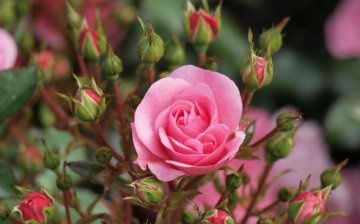
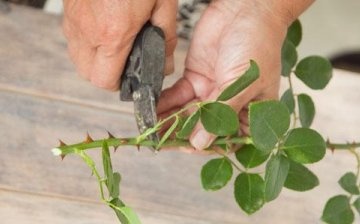
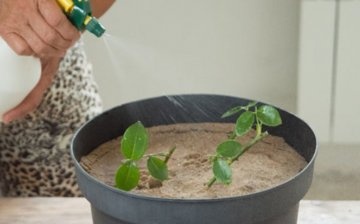
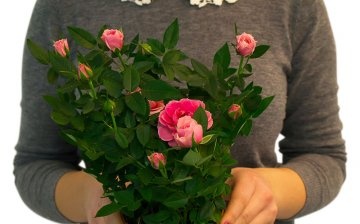
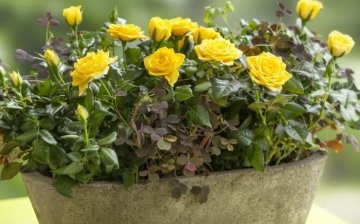
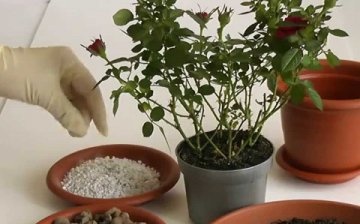
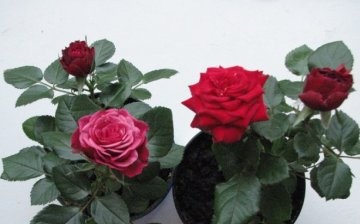










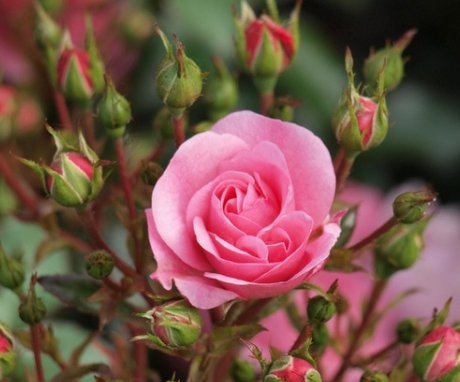
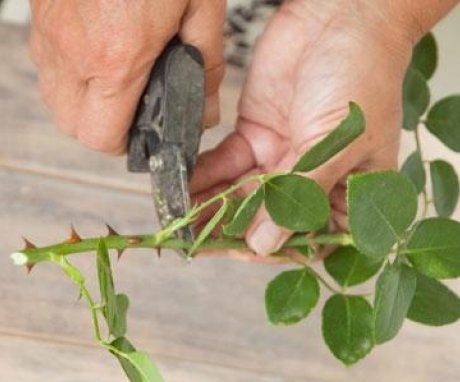
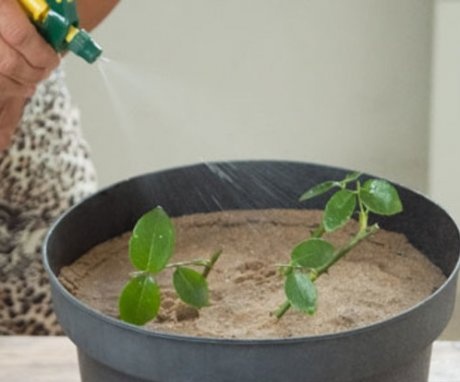
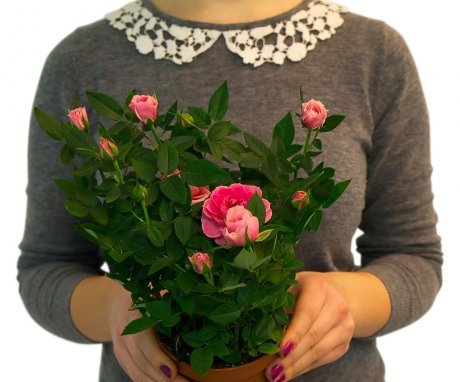
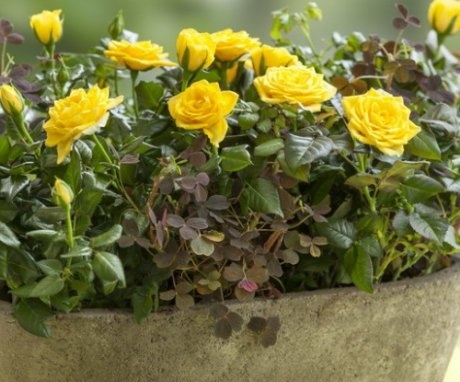
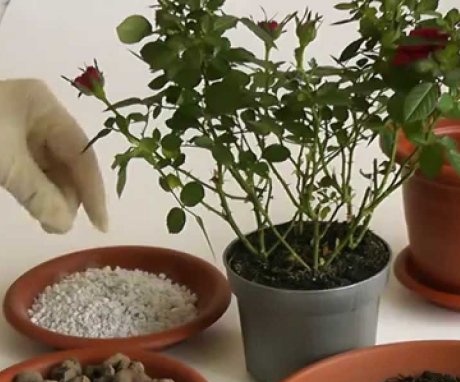
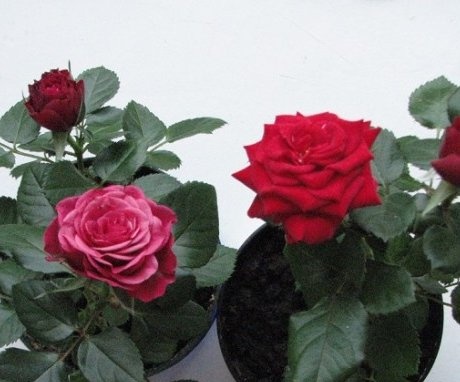
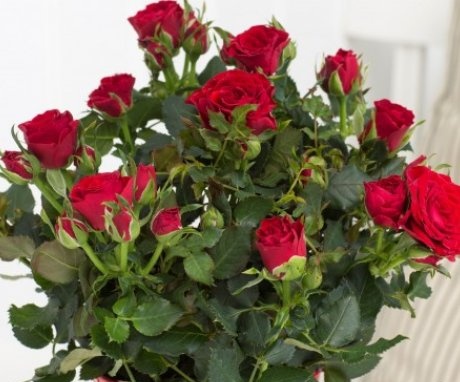
I tried to grow roses at home a couple of times, but for some reason I could not. I will definitely try again, taking into account all the recommendations in the article. I hope for a great result!